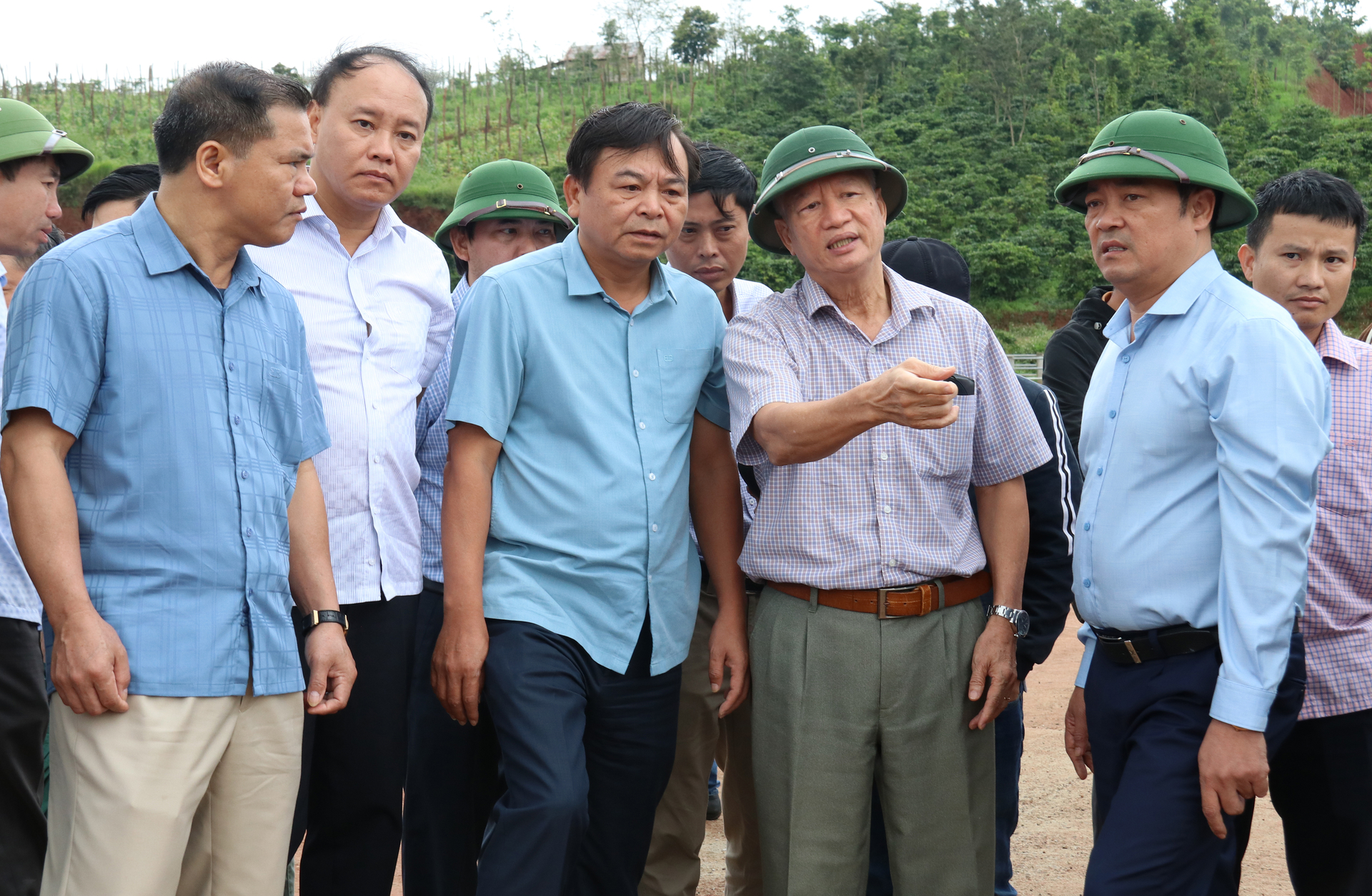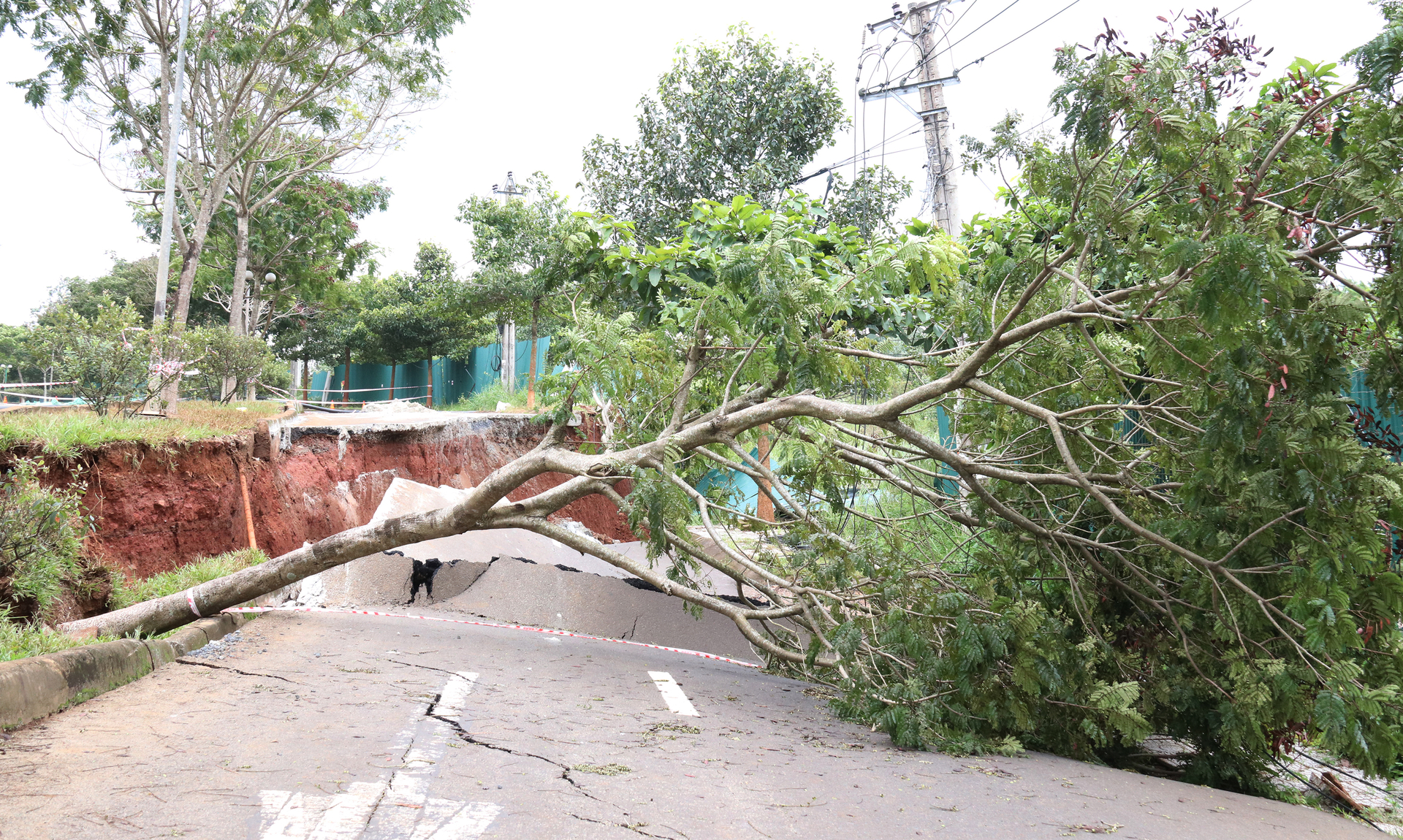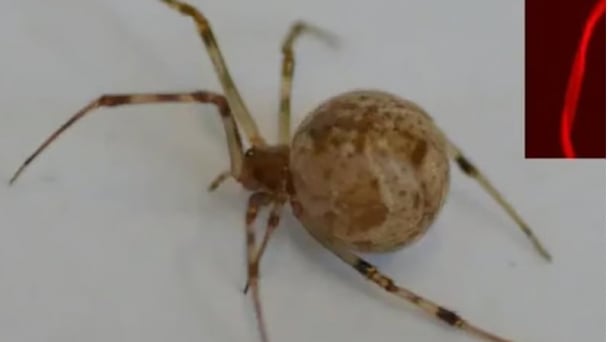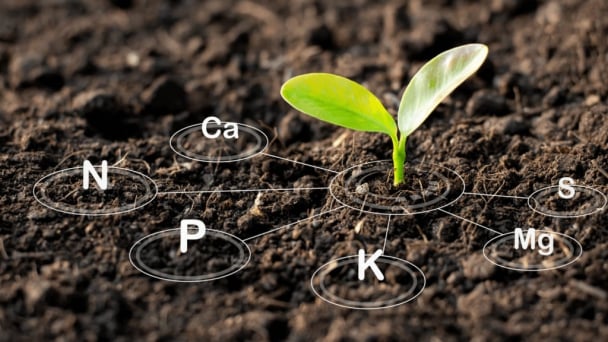May 20, 2025 | 10:46 GMT +7
May 20, 2025 | 10:46 GMT +7
Hotline: 0913.378.918
May 20, 2025 | 10:46 GMT +7
Hotline: 0913.378.918
On August 7th, Deputy Minister of the Ministry of Agriculture and Rural Development (MARD), Vice Chairman of the National Steering Committee for Natural Disaster Prevention and Control Nguyen Hoang Hiep, along with the working delegation, visited Dak Nong province to assess the situation of landslides and flooding that has occurred recently
According to the report from the provincial People's Committee of Dak Nong, from July 28th to August 6th, the province experienced continuous rainfall ranging from light to heavy and very heavy, lasting for several days. The total accumulated rainfall in the past few days has exceeded 300 mm at some measuring stations.
The prolonged heavy rainfall has caused severe damage to the region. Preliminary statistics show that the floods have resulted in 2 fatalities, affected 192 households with submerged houses, flooded approximately 651 hectares of various crops, and submerged around 217 hectares of aquaculture and 154 ponds owned by local residents. Additionally, numerous infrastructures, including bridges, have been damaged or swept away. As a result, 283 households had to be relocated to safe areas due to landslides and erosion. The estimated damage is over 250 billion VND.

Deputy Minister Nguyen Hoang Hiep and the delegation inspect the incident at the Dak N'ting irrigation project. Photo: Quang Yen.
In Dak Nong, the working delegation conducted an inspection of the Dak N'Ting irrigation project (in Quang Son commune, Dak Glong district), which is facing a serious risk of rupture. The Dak N'Ting irrigation project, with a capacity of 1.2 million cubic meters, was completed in 2021. Currently, there are approximately 1 million cubic meters of soil covering an area of over10 hectares near the dam shoulder, which is at risk of landslides and dam rupture. In addition to this project, a section of the Ho Chi Minh Highway passing through Gia Nghia town has suffered severe damage, with significant cracks continuously appearing and expanding.
Dr. Le Van Hung, an expert from the working delegation, assessed that the initial cause of the incident at the Dak N'Ting irrigation project was the instability and separation of the dam structure. "After surveying, the earth dam showed no visible signs of damage, but the possibility of potential issues in the future cannot be ruled out. The overflowing dam is affected, so water levels need to be lowered. The soil subsidence and collapse are due to dehydration during the dry season. When it rains, it weakens the cohesion and causes subsidence," said Dr. Le Van Hung.
He further stated that to prevent a dam rupture, the immediate measure is to release water quickly, and it is necessary to carefully consider the measures related to the irrigation project.
Regarding the Ho Chi Minh Highway, Dr. Le Van Hung suggested that in order to prevent further damage, immediate attention must be given to the issues of concentrated water accumulation. "The corrugated iron fence forms water reservoirs. If this issue is not addressed promptly, the entire road section will be seriously affected during this year's rainy season," added Dr. Le Van Hung.

Heavy rain caused the Ho Chi Minh road section in Dak Nong to be split in half, subsided for over 3 meters. Photo: Quang Yen.
Meanwhile, Dr. Nguyen Canh Thai, another expert from the working delegation, believes that the relevant authorities need to inspect the dam shoulders of the irrigation project in Dak Nong to determine if there are any issues and propose timely solutions. This is currently a crucial and focal point of concern. "Due to the shifting on the dam shoulder, it has affected the project. Currently, the landslide block is temporarily stable, but the specific causes of the hillside landslide need to be evaluated," Dr. Thai assessed, emphasizing that during the survey and project implementation, the investors have only focused on the specific project area.
"Limitations arise when investors do not conduct surveys around the site due to high costs. The calculations of rainfall are also limited, relying on past statistics. The authorities need to survey the depth of the landslide block, monitor the cracks, and implement appropriate measures. Particularly, the local authorities need to lower the groundwater level to facilitate water drainage. Reducing the slope at the bottom and managing the load above to prevent further landslides on the hillside," the expert added.
MARD’s Deputy Minister, Nguyen Hoang Hiep, revealed that at present, the amount of rainfall in Dak Nong is twice the annual average with 700 mm, and 1.5 times higher than that of 2022, which is unusual.
According to the Deputy Minister, we were already aware of this anomaly because from the beginning of the year, the National Steering Committee for Natural Disaster Prevention and Control had warned that even though this year's rainfall would be less, there would be unusually heavy rainfall concentrated within a specific period.
"As predicted, Dak Nong experienced heavy and concentrated rainfall in the first 10 days of July. The forecast for the next 15 days indicates a decrease in rainfall, but by the end of August, another period of rainfall is expected. Although it may be smaller than the previous one, it will still be significant. Therefore, Dak Nong needs to calculate and devise solutions; otherwise, the solutions proposed will not be in line with the actual situation," Deputy Minister Nguyen Hoang Hiep explained.

Deputy Minister Nguyen Hoang Hiep asked Dak Nong to prioritize the people's lives in response to natural disasters. Photo: Quang Yen.
Deputy Minister Hiep further stated that the working delegation will report to the Prime Minister, and the Ministry of Natural Resources and Environment will accurately and meticulously construct landslide maps in various localities, with a focus on the Central Highlands region. Currently, the landslide maps cover too broad an area. Additionally, the delegation will propose adjustments to the design standards.
"Traditionally, when implementing projects, the surveys have been confined to the project areas without extending to the surrounding areas. As we have seen in the case of collision in the Central Highlands region, the main cause of landslides is located outside the project areas," Deputy Minister Nguyen Hoang Hiep added.
Regarding localities, Deputy Minister Nguyen Hoang Hiep suggested that during planning, attention should be paid to areas prone to natural disasters and landslides. Investments near landslide-prone areas should be avoided to minimize the risk.
"Localities need to ensure an adequate number and quality of forests. In the Central Highlands region, an average of 5,000 to 7,000 hectares of forest is lost each year. The continuous decline in forest quantity and quality is a matter of great concern. Additionally, the natural flow of water needs to be respected. The current state of forests and their impact means that any disturbance will cause underground flow and contribute to causing landslides. Over time, the Central Highlands will become more hazardous, and the occurrence of landslides will become increasingly complex. Localities must also apply scientific and technical methods in disaster management and prevention to anticipate potential situations," Deputy Minister Nguyen Hoang Hiep said.

Dak N'ting irrigation works with a capacity of 1.2 million cubic meters of water are at risk of bursting. Photo: Quang Yen.
To address the immediate issues with the ongoing incidents in Dak Nong province, the Deputy Minister suggested that the local authorities should declare a state of emergency regarding natural disasters. By declaring an emergency, the locality can respond to situations with appropriate emergency plans. "Sometimes, when we prioritize safety too much, we become complacent and indifferent. We must fight against natural disasters; being overly cautious won't help. If one million cubic meters of soil collapses at the Dak N'Ting project, there's no point in discussing solutions in face of reality," the Deputy Minister said.
To handle these incidents, the first step for the localities is to identify the root causes accurately. Without identifying the root causes, it is impossible to address the issues properly. When dealing with these situations, the foremost requirement is ensuring the safety of the people before considering other matters.
"For the Dak N'Ting reservoir, the province needs to recalculate the worst-case scenario of dam failure. Although we don't wish for it to happen, we must plan for the worst-case scenario to handle the situation. The locality needs to conduct surveys, drilling, and monitoring to find the comprehensive causes of the landslides and come up with appropriate solutions. The focus should be on urgent measures to minimize the displacement of sliding masses. For the Ho Chi Minh road or other projects, the locality also needs to address issues related to rainfall and groundwater," Deputy Minister Nguyen Hoang Hiep urged.
This year, the Central Highlands region, including Dak Nong, is expected to face drought towards the end of the year, with a projected rainfall deficit of 25%. Despite the current rainy season, discussions on the drought situation at the year's end are necessary.
Translated by Nguyen Hai Long

(VAN) For years, the CRISPR-Cas9 genome technology has been reshaping genetic engineering, a precision tool to transform everything from agriculture to medicine.

(VAN) Vietnam aims to become a 'leader' in the region in the capacity and managing effectively soil health and crop nutrition.
![Reducing emissions from rice fields: [Part 1] Farming clean rice together](https://t.ex-cdn.com/nongnghiepmoitruong.vn/608w/files/news/2025/05/05/z6509661417740_a647202949c539012a959e841c03e1d3-nongnghiep-143611.jpg)
(VAN) Growing clean rice helps reduce environmental pollution while increasing income, allowing farmers to feel secure in production and remain committed to their fields for the long term.
/2025/05/19/5136-1-144800_230.jpg)
(VAN) The Nghe An Provincial People's Committee has just approved the list of beneficiaries eligible for revenue from the Emission Reductions Payment Agreement (ERPA) in the North Central region for the year 2025.

(VAN) 14 out of 35 domesticated elephants in Dak Lak province have had their living conditions improved, with 11 of them currently participating in the non-riding elephant tourism model.

(VAN) Muong Nhe Nature Reserve hopes that being upgraded to a national park will lay the foundation for forest protection efforts to be carried out in a systematic, modern, and sustainable manner.
/2025/05/16/3923-2-171845_52.jpg)
(VAN) Lower costs, higher yields, and improved soil quality are outstanding benefits that soybeans bring when integrated into the crop rotation system.